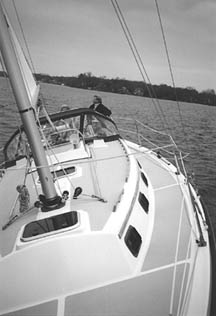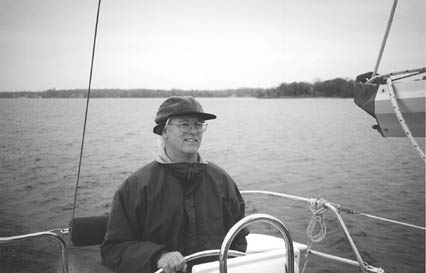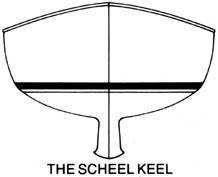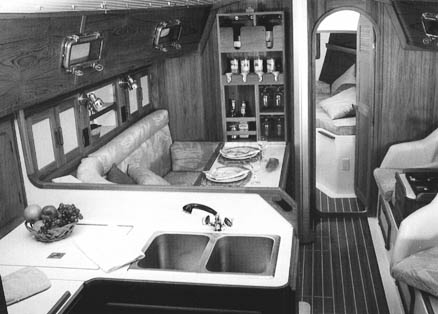
by Thom Burns

The well-known Charley Morgan designed the Com-Pac 35. She is a pleasing and affordable cruising sailboat. Morgan has designed and built everything from a challenger for the America's Cup (the 12-meter HERITAGE) to the most popular cruising auxiliary ever (over 30 feet) the Out Island 41. If there's anyone who knows about "built for speed" and "built for comfort" it's Charley. Over the years he's proven master of both, and a wizard at combining them.
Twenty some years ago Gerry Hutchins started a company to build the brand new Com-Pac 16. Designed by Clark Mills (who also designed the Optimist, perhaps the most-numerous sailboat on the planet) the first Com-Pac crammed overnight accommodations, 7-foot cockpit seats, and reasonable performance into a $3000 yacht. All this was accomplished with just 18 inches of draft. The little jewel has enjoyed great success over the years and is still in production. Com-Pac Yachts, Hutchins, Co. Inc., now builds the Com-Pac 35 and six models in between down to their new 14 foot Picnic Cat.
Builders often work their way up the size range and either forget their small boat heritage or leave large holes in their product lines because of bottom line issues. The Hutchins group hasn't strayed. Last year they introduced the Com-Pac 35, this year the Picnic Cat. All of their boats have traditional good looks, relatively shallow draft and cruising comfort regardless of the specific size. The 35 has a four-foot draft, a comfortable (46 percent) ballast/displacement ratio and lots of elbow room.

The 35 has a "Euro-transom" which not only adds a new look but incorporates a swim platform, too. The port-holes have given way to more contemporary rectangle ones which all open and come with screens.
Today's high-performance sailboats tend to be light, with fractional rigs and deep keels. The Com-Pac 35 is relatively heavy, has a balanced masthead rig, and a shoal keel. It's legitimate to wonder where her performance comes from, but after spending a cold afternoon on Lake Minnetonka with John "Henry" Cross and crew aboard his Com-Pac 35, I can tell you that it's there. She accelerates in moderate winds well. Morgan says that's because he minimized parasitic drag by sculpting a hull that has "clean lines."
The patented Scheel keel which also shows up on some Pacific Seacraft models helps performance in such a shallow draft craft. Thin at the top, thick at the bottom, it puts the majority of the boat's ballast where it will do the most good while creating a strong high pressure against side slippage. This keeps the 35 standing on her feet as the wind pipes up. The keel shape gains lifting efficiency by eliminating "crossover flow" from the high-pressure side to the low. It's the same "endplate" effect achieved by the successful modern winged keels.

There's a lot more than stability and speed that sets sailboats apart. Maneuverability is a big plus. The Com-Pac is a very pleasing sailboat because she turns quickly, easily and precisely. Morgan carried the Scheel "endplate" all the way to her spade rudder. Its shape plus its lever arm right aft of the keel maximize turning power giving the boat "sports car handling."
Most Scheel keels are castings that must be bolted onto the boat. Hutchins, however, achieves the complex keel shape by means of a segmented mold that lets hull and keel be laid up as a single unit. The keel cavity is then filled with ballast (lead ingots encapsulated in concrete). A double layer of bi-axial fabric is laid down the centerline to form a "backbone" for the laminate.
The hull/deck joint is accomplished by bolting the deck (on 3-inch centers) to an outboard flange at the sheer. That joint is then sealed on the inside with two layers of biaxial fiberglass tape and on the outside with a rigid rubrail capped with a stainless striker.
The aft quarter cabin to port is private and, while there are no drawers for stowage, it contains a good-sized hanging locker. The "master" double forward is well done with adequate stowage for a 35 footer.

Ten opening ports, four overhead hatches, and two well-sited Dorade vents combine to make the Com-Pac 35 one of the best-ventilated boats I've seen.
The boat's Westerbeke 3 cylinder, 27-horse diesel is used in some smaller boats, but I saw no signs that the 35 needs more power. She hit six knots at just over half throttle and she stopped with authority when backed down approaching the dock. The engine is mounted beneath the companionway where access is good.
Sailhandling gear alone is a 90's trademark and tells you how far we've come. The well-mounted roller-furler for the jib has a level-mounted control line. Full-length battens, along with a slick Dutchman furling system, are standard on the main. The mid-boom traveller keeps the cockpit clear for people.
Gerry Hutchins and crew have built a well-designed cruising boat. It'll do well from the shallow Bahamas cruising grounds to the rigors of Lake Superior and everything in between. From a hot and cold cockpit shower to a custom stainless bow pulpit with two built-in anchor rollers, from the foot of her keel-stepped mast to a roller-furler for her headsail, the 35 encompasses an impressive array of what's best for cruising today. She incorporates innovation where innovation counts while maintaining clean lines and brushes of tradition.
Captain Thom Burns publishes Northern Breezes and Sailing Breezes.
For more info: Onboard / Shorewood or
Com-Pac YachtsAll contents are copyright (c) 1998-2003 by Northern Breezes, Inc. All information contained within is deemed reliable but carries no guarantees. Reproduction of any part or whole of this publication in any form by mechanical or electronic means, including information retrieval is prohibited except by consent of the publisher.